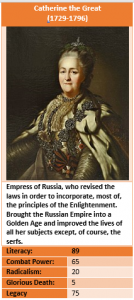by Ben Macready

The Second ‘Revolutionary Figure’ we shall be assessing in this series is Catherine the Great, the Empress of Russia from 1762-1796. Catherine is one of the final examples of, so called, ‘enlightened absolutism’ or ‘enlightened despotism’. A system of rule, wherein the monarch retains absolute autocratic power over their subjects, whilst at the same time applying the principles of the Enlightenment to the task of governance. Catherine can be seen as an archetypal example of an enlightened absolutist, due to the nature of the empire she ruled. The Russian tsars were bound by no constitution and though they did have advisors, Russia had no formal State Council until Alexander I created one in 1810 meaning that there were few checks in place to restrain her absolute power. Despite this, Catherine still enacted several egalitarian policies and made frequent claims to be acting in the name of the ‘common good’ an Enlightenment idea purported by Rousseau, Montesquieu and several offers. Her reign, and the reign of other enlightened absolutists prior to her, thus raises an intriguing question. Can a single person truly rule in the interests of all or is such an idea innately contradictory?
Despite eventually becoming empress of Russia, Catherine was born in Anhalt-Zerbst, a principality of the Austrian Holy Roman Empire. Born Sophie Auguste Fredericke on the 2nd May 1729, Catherine later changed her name to Ekatarina, which is commonly Anglicised as Catherine, upon her conversion from German Lutheranism to Russian Orthodox Christianity. Catherine’s claim to the Russian throne came through her marriage to Karl Peter Ulrich on 21 August 1745, when she was 16 years old. Peter was the nephew and heir of Empress Elizabeth I of Russia and took power upon her death in January 1792. Peter’s reign was short-lived, however, and he would be replaced by Catherine after only seven months. Peter, despite being Tsar of Russia, had been born and raised in the German duchy of Holstein. Whilst Catherine made every effort to assimilate with Russian culture, Peter made himself deeply unpopular as an emperor, due to an evident preference for the German people over his own Russian subjects. Most infamously, in one of his first acts as Tsar, Peter called back the Russian army, who were at the gates of Berlin, saving Prussia from certain defeat in the Seven Years War. The decision to withdraw the army was perceived as a disastrous move by the Russian court and military. It serves as a clear example of an incident where the wishes of the Autocrat and his subjects are at odds. Peter’s unpopularity led to him being deposed by a palace coup, an act which characterised Russian succession in the 18th century. The coup was led by a military officer named Gregory Orlov who, along with several of his siblings and a faction of nobles, removed Peter from the throne and place Catherine there in his stead. There is debate amongst historians, as to the degree to which Catherine herself was involved in the planning of the coup which deposed her husband. Yet whether Catherine orchestrated the coup herself or not, she ennobled the Orlov brothers for their services.
With Peter gone, and the reigns of power firmly in her own hands, Catherine set about reforming her new domain. She frequently corresponded with several Enlightenment thinkers, most notably Voltaire who she exchanged letters with for fifteen years. The influence of the Enlightenment can be seen in many of Catherine’s actions. In 1766, she finished a document entitled the Nakaz, which attempted to redefine the manner in which legal principles were perceived within Russia. The Nakaz sought to rationalise the Russian court system and make Russian law more consistent, and less arbitrary, in all spheres. The Nakaz was clearly inspired by many Enlightenment thinkers, yet at the same time it contained Catherine’s unique perspective on how justice and order should be administered. For all its modern principles, however, the Nakaz still enshrined law and justice as emanating from the Empress, rather than from the Nation or the People. The notion of law emanating from the sovereign was universally accepted in 1766, and had been for many centuries prior, yet would seem positively archaic in the aftermath of the American and French Revolutions, only a few decades away. In many ways, the Nakaz attempted to marry progressive ideas to Autocracy and acts as a clear demonstration of why Catherine can be called an Enlightened Absolutist. In December of 1766, Catherine summoned representatives of almost all of the major social groups within her empire to form an assembly and to discuss the issues facing them. The complaints raised by the assembly and the principles enshrined in the Nakaz were then used as guideline for reforming Russian law, so that it might amend the grievances those Catherine summoned to her court held towards the prior legal system.
Catherine’s reign also saw a massive rise in the availability of education to the Russian population. Increasing literacy rates was a major objective of Enlightenment thinkers and their advocates, as it was felt that only an educated public would be capable of grasping the complex conceptual ideas of the time. On the 5th August 1786 Catherine proclaimed a new Russian statute on education and opened several primary and secondary schools across Russia. Joining these schools was cost free and they were nominally open to all, however serf children could only attend such institutions at the behest of the nobles who owned them. One aspect of Catherine’s educational policy which made it particularly notable, was that education was made available to both genders. A series of ‘institutes for Noble Maidens’ were established which provided higher education for noble women, the Smolny Institute was the most famous of these institutions and would later serve as the Bolshevik’s base of operations during the October Revolution.
For all of her forward-thinking reforms and claims to be acting in the name of the ‘common good’ Catherine did not always act in the best interests of those she governed. For instance, the Serfs received no representative at the legislative assembly created to discuss the implementation of the Nakaz. The absence of the serfs is especially jarring, as the majority of Catherine’s subjects, more than five million people, were serfs (1). Their absence was justified, under the assumption that their masters would be sufficiently able to speak for their needs. A remarkably regressive viewpoint, especially considering the Nakaz’s stated purpose of incorporating modern, enlightened principles into Russia’s legal system. Furthermore even some of Catherine’s attempts at Modernisation resulted in popular dissatisfaction. Surveyors were sent out to ensure that as much arable farmland land was used, in as optimal a manner as possible. This placed great demand on the serfs and peasantry and pushed them to work significantly harder than before, leading to widespread dissatisfaction. As such in 1773 the Serfs rebelled against her, rallying behind Yemelyan Pugachev, a charismatic ex-officer of the Tsarist army who claimed to be Peter III returning to reclaim his rightful throne. Though the Pugachev rebellion was ultimately put down, it lasted until 1775 and the large-scale of the rebellion damages Catherine’s claim that she was always capable of acting in her people’s best interests.
The three partitions of Poland, which Catherine benefitted from, also demonstrate a manner of ruling which is somewhat less than Enlightened. Territory from the Polish-Lithuanian Commonwealth was taken and retributed between Russia, Prussia and Austria in 1772, 1793 and 1795. After the third partition, all the commonwealth’s former territory had been seized by the three great powers, removing Poland from the map of Europe completely until 1918. This demonstrates no acceptance of the Principles of Nationalism and self-determination which were beginning to develop with the onset of the French Revolution. Catherine’s complicity in the partitions shows her playing at classical Great Power politics.
Catherine the Great was thus capable of bringing about modernisation through autocratic means. She acts as a demonstration of the fact that, the ‘Ancien Regimes’ which predated the Age of Revolutions were not entirely built upon regressive principles. Whilst she failed to exercise her power in a form that met the needs of the Serfs, who made up the majority of the population of her empire. It cannot be denied that her reign brought about significant advancements to the Russian legal and educational systems. Catherine the Great is thus a revolutionary figure, not because she attempted to tear down the established order, but because she attempted to bring it in line with modern principles.
- Simon Dixon, Catherine the Great, (2001) p.127
Further Reading
Simon Dixon, Catherine the Great
W Gareth Jones, The Spirit of the “Nakaz”: Catherine II’s Literary Debt to Montesquieu
John T Alexander, Catherine the Great : Life and Legend
